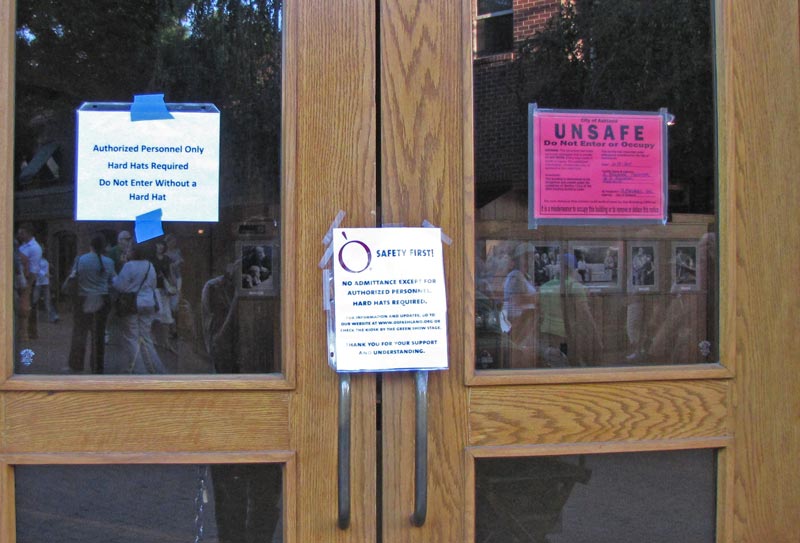Playing Around

(Entrance to the Bowmer Theater)
We’re in Ashland, OR for our annual haj to the Oregon Shakespeare Festival. Once again, my mom has flown in from Toledo to attend with us, and once again, the weather is so far hot & sunny, such a change from the cool & overcast spring we’ve had in Seattle.
One big glitch: On the day before our departure, I received an email from the Festival that they’d discovered structural damage to a central beam in the large indoor Bowmer Theater, and that it would be closed indefinitely. This was a pretty large deal, since 4 of our 8 plays were scheduled to be performed there:
- To Kill A Mockingbird
- Measure for Measure
- Imaginary Invalid (a Moliere)
- August: Osage County (a contemporary play by Tracy Letts set in small-town Oklahoma)
We were left with:
- Pirates of Penzance
- Love’s Labors Lost
- Henry IV, Part 2
all in the outdoor Elizabethan Theater, and:
- Julius Caesar
in the small indoor New Theater.
Since my mom was already in town, and we already had our airfare to and lodging in Ashland paid for, there was no thought of canceling.
As events progressed, the Festival devised a way to stage the canceled plays in the cavernous old Armory building just up Oak Street from our lodging, so we lined up in the street Tuesday afternoon to see if we could get a seat for To Kill A Mockingbird. As it happened, there were plenty of seats inside, all on folding chairs in neat rows in a huge auditorium. There was a certain sense of disenfranchisement, since I had bought front-row tickets for all of our plays last November in the members’ presale, and our seats in the Armory were more than halfway back. Still, kudos to the Festival for going outside the box to deliver the product. And, the Armory performances are free to anyone who held tickets to the original performances; we got our choice of cash refunds or vouchers for future performances of any play, this year or next. I selected vouchers, since I have a glimmer in my eye about another trip down here later in the year, after they (hopefully) have re-opened the Bowmer.
To Kill A Mockingbird
I had never read the book, nor seen the movie, so this was my first introduction to the story. The production in the Armory was done without costumes, props or stage sets. It opened with the full cast on stage, sitting on folding chairs in a semicircle, with an adult incarnation of Scout narrating. As she was reminiscing about that fateful summer, actors would rise from their chairs and create a flashback tableau of dramatic action, and the voice would pass from the adult narrator to a pre-adolescent Scout.
As the production progressed, the actors involved in dialogue used an area about 10′ by 10′ to represent their interactions, and their strength of delivery did a lot to overcome the lack of visual context.
The story itself has two major plotlines: the first, the depiction of the Finch family and the development of Atticus Finch’s character as a father and citizen; the second, the civic and legal developments leading to the trial and its outcome. To begin to appreciate either, it’s necessary to be able to place yourself in Depression-era, small-town Alabama. This is where the lack of scenery and the first-rate production values of the Festival is quite apparent. The surfeit of family sagas and courtroom drama in the cinema and on the screen in the ensuing decades overwhelms this work taken in its components; it would make an ordinary episode of Law & Order. It really needs to be viewed through its temporal and geographical context.
What gives the story its spark is the collision of these two plotlines: the precipitous ripping of the Finch family from its comfortable niche near the top of the town’s social foodchain and making them the embodiment of all its resentments, armed only with a nascent moral carapace; and the journey of Jem and Scout from a mostly passive and credulous acceptance of the world as viewed through Atticus’ lens, to the crescendo of lurid and unvarnished images that are thrust upon them.
This last thread, the passage of the kids from Atticus’ protection and control, is almost lost in the hurly-burly of the trial. It begins with their unbidden, perhaps forbidden, foray to the jailhouse to stand with Atticus, and extends as they assert themselves (as invited guests) to view the trial from the black folks’ gallery.
I’m curious now to read the book and join the majority of the civilized world. I’d like to see how Lee’s prose stands up to the expectations of its myth. I’d also like to learn the elements of backstory necessarily excised from the play.

What?! Never read the book, never seen the movie?! I first read Mockingbird as an adult–and just like when I finally watched Casablanca, I thought “Oh! So that’s why everybody loves this!” I’d be interested to hear what you think of the book. And, um, you have seen Casablanca, right?